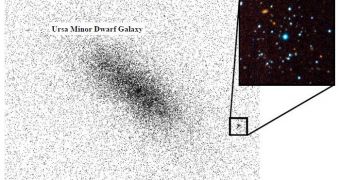In a scientific paper to be published in an upcoming issue of the esteemed Astrophysical Journal Letters, astronomers detail how the dimmest known star cluster was discovered on the outskirts of the Milky Way. The discovery sets new boundaries for how small and dim these objects can be.
Star clusters come in several types, ranging from disorganized to globular. They are basically nothing more than stellar associations, where tens to thousands of stars are bound together – either strongly or loosely – by mutual gravitational influences.
The object, now known as Muñoz 1, contains somewhere in the vicinity of 500 stars, which together produce an extremely-dim light. For comparison, the average star cluster contains around 100,000 members, and produces an easily detectable light signature.
One possible explanation for how small and dim this star cluster is could be that it was once much larger and brighter, but that it lost numerous stars as it passed right through the Milky Way. The object was discovered as astronomers were investigating the dwarf satellite galaxy Ursa Minor.
Scientists conducted the observations using the Canada-France-Hawaii Telescope, on the summit of Mauna Kea, in Hawaii, Space reports. “It's ridiculously dim. There are individual stars that would far outshine this entire globular cluster,” Yale University astronomer and team member, Marla Geha, says.
“We know of about 150 clusters around the Milky Way,” adds University of Chile astronomer Ricardo Muñoz, who discovered the cluster while studying Ursa Minor, Space reports.
“This is the faintest and most distant one, which means there are probably a lot of them we haven't found. It seems like there cloud be an order of magnitude more clusters than we thought there were,” he goes on to say.
Experts hypothesize that some of the largest galaxies in the Universe may contain tens of thousands of star clusters. In all likelihood, the Milky Way contains many more clusters than what scientists have found thus far, but our galaxy is of medium size, at a diameter of just 100,000 light-years.
“The first paper I wrote was on Ursa Minor so I've always liked that object. Now we have deeper data. While I was playing around with the data, I noticed this tiny little thing sort of southwest of Ursa Minor, but still very close,” Muñoz reveals about discovering the cluster.
The object was confirmed with the Keck II telescope, which is also perched atop Mauna Kea. Spectroscopic measurements from the giant instrument allowed experts to measure how fast stars in the cluster were moving.
Since these speeds were different from those of stars in Ursa Minor, this led experts to determine that the two structures were different.

 14 DAY TRIAL //
14 DAY TRIAL //